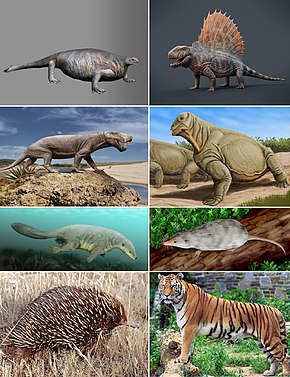| Synapsida Temporal range:
| |
|---|---|

| |
| Examples of synapsids (left to right, top to bottom): Cotylorhynchus, Dimetrodon, Inostrancevia, Moschops, Castorocauda, Adelobasileus, Tachyglossus aculeatus, and Panthera tigris | |
| Scientific classification | |
| Domain: | Eukaryota |
| Kingdom: | Animalia |
| Phylum: | Chordata |
| Superclass: | Tetrapoda |
| Clade: | Reptiliomorpha |
| Clade: | Amniota |
| Clade: | Synapsida Osborn, 1903 |
| Subgroups | |
| Synonyms | |
|
Theropsida (Seeley, 1895)[6] "Pelycosauria" (Cladistically including therapsids) | |
Synapsida[a] is one of the two major clades of vertebrate animals in the group Amniota, the other being the Sauropsida (which includes reptiles and birds). The synapsids were the dominant land animals in the late Paleozoic and early Mesozoic, but the only group that survived into the Cenozoic are mammals.[7] Unlike other amniotes, synapsids have a single temporal fenestra, an opening low in the skull roof behind each eye orbit, leaving a bony arch beneath each; this accounts for their name.[8] The distinctive temporal fenestra developed about 318 million years ago during the Late Carboniferous period,[1] when synapsids and sauropsids diverged, but was subsequently merged with the orbit in early mammals.
The animals (basal amniotes) from which non-mammalian synapsids evolved were traditionally called "reptiles". Therefore, synapsids were described as mammal-like reptiles in classical systematics, and non-therapsid synapsids were also referred to as pelycosaurs, or pelycosaur-grade synapsids. These paraphyletic terms have now fallen out of favor and are only used informally (if at all) in modern literature. It is now known that all extant animals traditionally called "reptiles" are more closely related to each other than to synapsids, so the word "reptile" has been re-defined to mean only members of Sauropsida (bird-line Amniota) or even just an under-clade thereof, and synapsids are not part of the sauropsid lineage in a cladistic sense.[9][10][11][12] Therefore, calling synapsids "mammal-like reptiles" is incorrect under the new definition of "reptile", so they are now referred to as stem mammals, proto-mammals, paramammals or pan-mammals.[13][14][15]
Synapsids were the largest terrestrial vertebrates in the Permian period, 299 to 251 million years ago, equalled only by some large pareiasaurs at the end of the Permian. Most lineages of pelycosaur-grade synapsids were replaced at the end of the Early Permian by the more advanced therapsids. Synapsid numbers and variety were severely reduced by the Permian–Triassic extinction event. Only the therapsid dicynodonts and eutheriodonts (consisting of Therocephalia and Cynodontia) are known to have continued into the Triassic period. The cynodont group Probainognathia, which includes Mammaliaformes (mammals and their closer ancestors), were the only synapsids to survive beyond the Triassic.[16]
During the Triassic, the sauropsid archosaurs became some of the largest and most numerous land vertebrates, only rivaled in size by kannemeyeriiform dicynodonts, and gave rise to the dinosaurs. When all non-avian dinosaurs were wiped out by the Cretaceous–Paleogene extinction event, the mammalian synapsids diversified again to become the largest land and marine animals on Earth.
- ^ a b Steen, Margaret C. (1934). "The amphibian fauna from the South Joggins. Nova Scotia". Journal of Zoology. 104 (3): 465–504. doi:10.1111/j.1096-3642.1934.tb01644.x.
- ^ David S. Berman (2013). "Diadectomorphs, amniotes or not?". New Mexico Museum of Natural History and Science Bulletin. 60: 22–35.
- ^ Klembara, Jozef; Hain, Miroslav; Ruta, Marcello; Berman, David S.; Pierce, Stephanie E.; Henrici, Amy C. (2019). "Inner ear morphology of diadectomorphs and seymouriamorphs (Tetrapoda) uncovered by high‐resolution x‐ray microcomputed tomography, and the origin of the amniote crown group". Palaeontology. 63: 131–154. doi:10.1111/pala.12448.
- ^ Brocklehurst, N. (2021). "The first age of reptiles? Comparing reptile and synapsid diversity, and the influence of lagerstätten, during the Carboniferous and early Permian". Frontiers in Ecology and Evolution. 9: 669765. doi:10.3389/fevo.2021.669765.
- ^ Simões, T.; Kammerer, C. (August 2022). "Successive climate crises in the deep past drove the early evolution and radiation of reptiles". Science Advances. 08 (33): eabq1898. Bibcode:2022SciA....8.1898S. doi:10.1126/sciadv.abq1898. PMC 9390993. PMID 35984885. S2CID 251694019.
- ^ Seeley, Harry Govier (1895). "Researches on the structure, organisation, and classification of the fossil reptilia. Part X. On the complete skeleton of an anomodont reptile (Aristodesmus rutimeyeri, Wiedersheim), from the Bunter sandstone of Reihen, near Basel, giving new evidence of the relation of the Anomodontia to the Monotremata". Proceedings of the Royal Society of London. 59: 167–169. doi:10.1098/rspl.1895.0070.
- ^ Laurin, Michel; Reisz, Robert R. (2011). "Synapsida: Mammals and their extinct relatives" (Version 14 ed.). The Tree of Life Web Project.
- ^ Romer, A.S; Parsons, T.S. (1985). The Vertebrate Body (6th ed.). Philadelphia, PA: Saunders.
- ^ Carroll, Robert L. (1988). Vertebrate Paleontology and Evolution. New York, NY: W.H. Freeman & Co. p. 397. ISBN 0-7167-1822-7.
- ^ D. W. Dilkes, R. R. Reisz (1996). "First Record of a Basal Synapsid ('Mammal-Like Reptile') in Gondwana". Proceedings of the Royal Society B. 263 (1374): 1165–1170. doi:10.1098/rspb.1996.0170.
- ^ Benton, Michael J. (2005). Vertebrate Palaeontology (3rd ed.). Oxford, UK: Blackwell Science Ltd. p. 122. ISBN 0-632-05637-1.
- ^ "Jaws to ears in the ancestors of mammals". evolution.berkeley.edu. Retrieved 2020-02-20.
- ^ "New proto-mammal fossil sheds light on evolution of earliest mammals". University of Chicago. August 7, 2013.
- ^ Naish, Darren. "The Stem-Mammals--a Brief Primer". Scientific American Blog Network. Retrieved 2022-02-27.
- ^ Cite error: The named reference
M2021was invoked but never defined (see the help page). - ^ "Greatest mass extinction responsible for the making of modern mammals" (research publ. ann.). Bloemfontein, ZA: The National Museum [of South Africa]. 19 September 2013. Archived from the original on 2019-03-28. Retrieved 2015-08-22.
Cite error: There are <ref group=lower-alpha> tags or {{efn}} templates on this page, but the references will not show without a {{reflist|group=lower-alpha}} template or {{notelist}} template (see the help page).